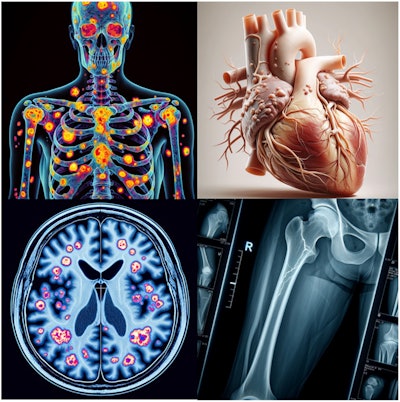Nuclear medicine experts support the use of AI to improve sustainability of practices in the field, yet said implementation will require careful consideration of the technology’s benefits and detriments, according to an article published April 6 in Radiography.
Lead author Geoff Currie, PhD, of Charles Sturt University in New South Wales, Australia, and U.S. colleagues, discussed the potential for AI across what they describe as the “five pillars” of sustainability in nuclear medicine (social, human, economic, ecological, and environmental) and noted its benefits and threats in each pillar.
“AI, digital twins, and generative AI offer potential benefits to sustainability in nuclear medicine," the group wrote. "There are benefits across each of the five pillars of sustainability, yet caution is advised."
The authors noted that while their discussion leans heavily on their own previously published work, in this article, they aimed to reframe their expertise and insight within the “important context of sustainability.”
Artificial intelligence
AI algorithms have been developed that can rapidly and autonomously reconstruct serial PET/CT images in oncology patients, for instance, and compare radiomic features across the time series. This improves sustainability across all five pillars, they wrote, by creating greater accuracy and reproducibility, providing richer data insights, improving patient outcomes, and reducing the computational burden on human resources.
However, some may argue that the explosion of these AI tools, many of which utilize cloud computing technology, may negatively impact environmental sustainability through increased use of energy, they noted.
Digital twins
Most applications of digital twins (simply a digital replica of an actual object) relate to optimizing patient management and outcomes, or person-centered care, the group wrote. In doing so, they contribute to social, ecological, and economic sustainability, the authors noted.
Combining deep-learning approaches and digital twins, for instance, could enable accurate predictions of Lu-177 PSMA-617 (Pluvicto) biodistribution over time based on the pretherapy diagnostic scans.
Yet digital twins need to consider social sustainability because they have the capacity to either improve social asymmetry in healthcare or worsen inequity, and consequently their use needs to adhere to an ethical framework, they added.
Generative AI
Generative AI like ChatGPT can be a valuable tool for health professionals or patients to learn and expand their knowledge on a variety of topics, yet as a tool for patient education, it can be misleading, confusing, and undermine the social pillar of sustainability, the authors wrote.
Moreover, the use of ChatGPT-4 (subscription version) with DALL-E−3 for image interpretation and generation may be an interesting option, but it has a ways to go before it is useful for either education, physician assistance, or patient support, they noted.
 ChatGPT powered by GPT-4 and using DALL-E−3 was asked to generate an image for teaching purposes that demonstrated: a nuclear medicine bone scan with skeletal metastases (top left); coronary artery disease (top right); an F-18 FDG-PET scan of the brain with Alzheimer's disease (bottom left); and an x-ray showing a fracture (bottom right). These are misleading for educational purposes and for patients who may be searching for information. Image and caption courtesy of Radiography.
ChatGPT powered by GPT-4 and using DALL-E−3 was asked to generate an image for teaching purposes that demonstrated: a nuclear medicine bone scan with skeletal metastases (top left); coronary artery disease (top right); an F-18 FDG-PET scan of the brain with Alzheimer's disease (bottom left); and an x-ray showing a fracture (bottom right). These are misleading for educational purposes and for patients who may be searching for information. Image and caption courtesy of Radiography.
“Adopting generative AI for such uses is a significant threat to social, economic, and ecological pillars of sustainability,” the group wrote.
Perhaps the best use of generative AI in sustainability is in student education, the authors added.
“Implemented with care and within a rigorous ethical framework, however, these frontier technologies should position nuclear medicine for the horizon and beyond,” the group concluded.
Currie’s coauthors included Kristina Hawk, MD, PhD, of University of California San Diego, CA, and Eric Rohren, MD, PhD, of Charles Sturt University and Baylor College of Medicine in Houston, TX.
The full article is available here.




















